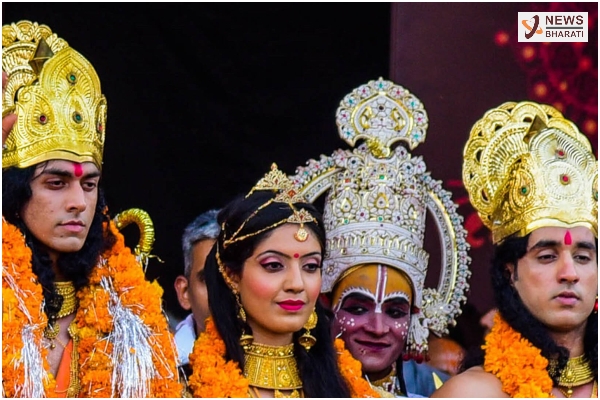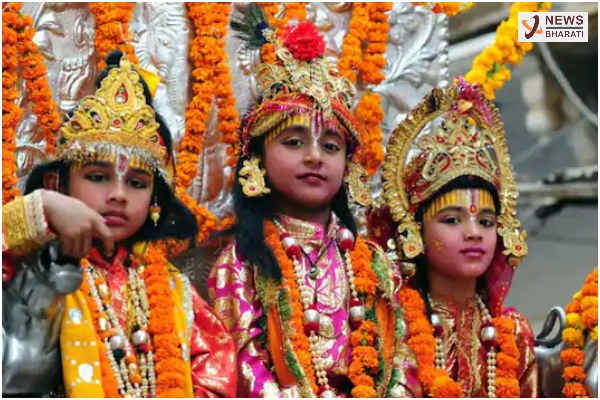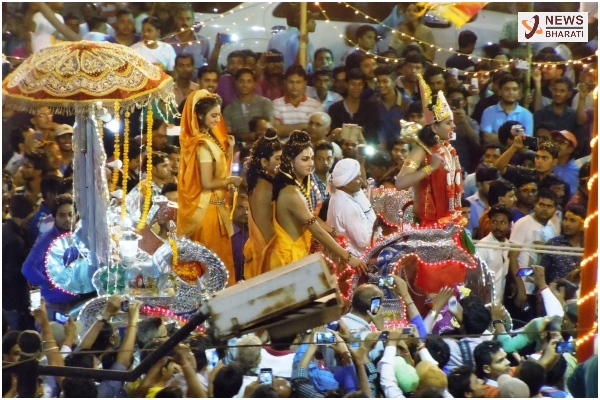Ramayana in North-east India! The Universality of the Story of Sri Ram
17 Apr 2021 11:53:38
As long as mountains stand and the rivers flow on the earth Ramayana will survive upon the lips of men.
The influence of Ramayana or the Story of Sri Rama has its deep impact on the human psyche; especially it has cut deep roots in the Hindu society since the hoary past. The great epics Ramayana and Mahabharata have always been and will be subjects of interest for the storytellers and the masses too.
We all are aware of the deep impressions the story of Ramayana has carved on the psyche of the Indian society. This became evident when the “Ramayana” television serial was first telecast in the early 1980s. The massive response it evoked was simply amazing; people of all age groups were found glued to their television sets and one would experience a self-declared curfew sort of as no one would venture out during that one-hour slot. Even the timings of public functions and muhurts of marriages were adjusted according to the serial timings on Sundays. Such was the influence of Ramayana then!

Recently, the country witnessed the massive “Nidhi Samarpan” drive for construction of Sri Ram Mandir at Ayodhya-the birthplace of Sri Ram. Nearly 5.6 lakh RSS swayamsevaks visited 12.5 crore families across the country and collected their offerings for the temple construction under the aegis of Sri Ram Janmabhumi Teerth Kshetra Trust. This was unique and unparalleled in our times.
Not only in India the story of the Prince of Ayodhya has made its impact on the societies across the globe, more particularly in the South and South East Asian nations. The stories of Ram, Sita, Lakshman, Hanuman and some other characters of Ramayana found to have penetrated through the rural, urban, mundane, religious, sacred and secular domains of the human societies. The original story told by Sage Valmiki has undergone some changes in the literary, oral and pictorial aspects of the Ramayana rendered in these societies with a unique local flavor.
The story of Ramayana is simple to follow, straightforward and appealing to the common masses easily. It is not as complicated as that of Mahabharata. That makes it the best of all. The contribution of the story of Sri Ram in developing personal, social and national character is remarkable. The original story told by ‘Adikavi’ Valmiki has been rendered in various languages, forms, and folk narrations in all parts of India and even abroad. Muslim jogis of Mewat region sing ballads woven around Sri Ram, composed by Nizaamat Mev, some 360 years ago. The Muslim Manganiyars have their own repertoire of Bhajans based on the entire Rama story.
Outside India, Ram Katha is translated in many languages. It has been the inseparable part of culture and traditions in Muslim majority Indonesia, Java, Sumatra, Malaysia and other countries. The capital of Thailand is called 'Ayudhya' and the King uses the epithet Ram in his name. Before the disintegration of the USSR, a Russian poet Bobo Khoji translated the Ramayana in the Tajik language. The first print order of Tajik translation of Ramayana crossed 15000 copies, Soviet Information Centre had said. Bobo Khoji said that the Ramayana has something in common with the epics of other nations like the ‘Iliad’ and ‘Odyssey’ of Greek, the Tajik-Persian ‘Shah Namah’, the Finish ‘Kalevala’ and the Kirghiz ‘Manas’. He says that each of these epics deal with the eternal battle between good and evil and glorifies nobleness, heroism, freedom, justice and loyalty.
During the British occupation, large numbers of Indian workers were taken to countries like Surinam, Kenya, Guyana and Mauritius under the British Empire to work in the plantations. These workers were mostly from the backward regions of Uttar Pradesh, Bihar, Odisha etc. They were taken there under a special agreement hence they came to be known as ‘Girmitia’ (corrupt form of Agreement). Today, the umbilical cord of these ‘Girmitia’ Indians is connected with mainland India because of the Ramayana only. They carried the ‘Ramcharitmanas’ or ‘Tulsi Ramayana’ with them and continued to recite generations after generations. Because of this relation, the Ramayana television serial could be aired in Mauritius.

It is an irony of fate that the British who tried to subjugate the Indian society by introducing their education system and breaking the backbone of our culture, have today introduced Ramayana in their school curriculum and to their surprise this has brought a remarkably positive change in the behavior of the students there! The Ramayana TV serial was even popular in Pakistan and other countries. We have seen and experienced the popularity of this story of Sri Ram when Ramayana was again telecast during the Corona Lockdown One last year. This underlines the fact that Ramayana has a universal appeal cutting across the barriers of cultures, languages, traditions and civilizations. It has its influence cast even in this 21st century due to its vast appeal. Ramayana is not just confined to India; it is a global phenomenon that defies all the geographical and regional limitations. For the last 2000 years Ramayana which first sprang to life in India has been transplanted to countries of South and South East Asia. The story was then simulated and transformed by those countries accommodating their local history, geography and the way of life.
It is this universal appeal of Ramayana that has encompassed the urban and rural populace, has also influenced the people living in deep forests, mountains, jungles and remote areas. The population of forest-dwellers living in various provinces of India has crossed five crore with majority of them living in the border areas of the country. Among them also the presence of Ram Katha is found but the story seems to have undergone sufficient changes according to the social conditions and compulsions but the core of the story remains unaltered.
Many versions of Ramayana are found among the Bhils, Mundas, Santhals, Gonds, Sauras, Korkus, Rabhas, Bodo-Kacharis, Khasis, Mizos and Meiteis and other forest-dweller communities. These communities have woven the story of Sri Ram with their own plots and sub-plots in the text retaining the original thematic and structural unity of Ramayana. Linking the text with local geography and rituals; by incorporating songs and narratives from the native repertoire; and by making the characters follow moral and ethical codes of the community, each group renders its version locally and contextually bound, many a times making it an ancestral tale of its origins. Besides, oral transmission and reliance on people’s memory for story materials are mainly responsible for different Ramayana versions that vary from region to region.
Looking at such a variety of different versions of Ramayana famous archaeologist the late V S alias Haribhau Wakankar had underlined the need for collection of such versions and conducting research on them. He most appropriately named them as ‘Van Ramayana’. These ‘Van Ramayana’ versions are important from yet another angle. Sri Ram spent a considerable period of his 14-year exile in forest and in company of the forest-dwellers. Giving up his coronation ceremony, Sri Ram ventured out along with his consort Sita and brother Lakshman on a 14-year-long exile during which he was asked by his stepmother Kaikeyi to stay in the Dandaka forest. From his meeting with Nishadraj Guh at the border of Ayodhya to his association with Vanara King Sugreev and his wise minister Hanuman, Sri Ram, Lakshman and Sita constantly remained in the company of these forest-dwellers.
These communities included the Nishads, Gridhras, Vanaras, Rikshas etc. All these communities were simple, nature-loving and pure at heart but were constantly living under the fear of the Rakshasas led by their King Ravana. They were unorganized and hence more prone to exploitation from the mighty demons. It was Sri Ram, his consort Sita and his brother Lakshman who organized these forest-dwellers, injected in them the elixir of hope and confidence and prepared them to take head-on with the mighty Rakshasa forces and defeat them. This is the history of Ramayana and क्रियासिद्धि सत्त्वे भवती महतां नोपकरणे is the message underneath it. We can now only imagine how the Prince of Ayodhya would have taken efforts to organize these communities and injected in them a new hope of life and commitment to a mission that prepared them to successfully defeat the evil forces and establish the rule of justice, equality, mutual love, brotherhood, peace and progress.
Since last so many years systematic and consistent conspiracies are going on to segregate these forest-dwelling communities who are commonly known as ‘Tribal’ or ‘Adivasi’ from the main society by cutting their cultural roots. These conspirators, mostly the Christian missionary and church organizations, constantly hammered these communities about their being the ‘aboriginals’ of this land who were pushed to the difficult and remote forest lands by the invading hoards of the ‘Aryans’. Now these very ‘Aryans’ are trying to ‘Hinduize’ and subjugate them to the majority. Such mischievous propaganda has gained some ground in some pockets of the ‘janjatis’ or the ‘Scheduled Tribes’ as our Constitution describes them. Such malicious propaganda can be countered effectively by research and interpretation of these ‘Van Ramayana’ versions highlighting and focusing on the actual work done by Sri Ram in organizing and consolidating these communities long before these conspirators and their religion was born.

Sri Ram’s journey southwards to Dandaka Forest passed through the present-day states of Uttar Pradesh, Madhya Pradesh, Maharashtra, Andhra Pradesh, Telangana, Karnataka, and Tamil Nadu to Sri Lanka. The trio of Sri Ram, Sita and Lakshman wandered through the forests and valleys, mountains and plains. It was but natural that they came in contact with the ‘janjatis’ living in these areas. But it is quite surprising to find the presence of Sri Ram Katha among the ‘janjatis’ of the North-east India where Sri Ram never went during his lifetime. This can be termed as a sweet coincidence.
Ram Katha versions are found to exist among the different janjatis dwelling in the northeastern region including the Bodo-Kacharis, Rabhas, Missings, Tiwas or Lalngs, Karbis, Dimasas, Jaintias, Khasis, Taraon Mishmis. The Mizos, 95 percent of whom are converted to Christianity, also have folk stories influenced by the Rama legend. They believe that it was Sri Ram and Khena (Lakshman) who taught them to cultivate paddy. Similar story is found in vogue among the janjatis living in Bundelkhand area. In Manipur Ram Katha is performed in Wari-leeba (traditional story-telling), Pena-sakpa (ballad singing), Khongjom Parva (narrative singing accompanied by Dholak) and Jatra (folk-theatre) styles. Buddhism is considered as one of the principle source of Ramayana Tradition in the East, South, South-east Asian and north-east Indian communities. Here among the Tai-Phake community Ram is Bodhisattva. The Buddhist influence is also visible on the story of Sri Ram among the Khampti community of Arunachal Pradesh.
In Assam, where majority follows the Vaishnava Sect propagated by Sri Sankardeva, the rendition of original Valmiki Ramayana is available in Assamese. It was poet Madhav Kandali who translated the Valmiki Ramnayan into Assamese in 14th century. However, popular and folk traditions in Assam continue to be associated with the story of Sri Ram in this region. In Assam, Ram-Vijaya, a play composed by Sri Sankaradeva, and based on Madhava Kandali’s Ramayan is very popular and is staged in Ankia nat and Bhaona style. Another tradition that of Ramayan-gowa ojapalis, incorporates song, dance and drama. Kusan-gan is a vibrant folk drama and derives its name from Ram’s son Kush.
There is a folk song popular among the Rabha community in Assam. Roughly translated it says, “The sacrificial horse of Sri Ram is coming to our land. Come, let’s go and have a glimpse of it”. Sri Ram performed the ‘Aswamedh Yagya’ when he let lose his sacrificial horse to wander and bring the kings and chieftains under his rule. So, Sri Ram did not come to our land but his horse is coming and thus goes the song. The Karbis inhabiting the Karbi Anglong district of Assam have the complete story of Sri Ram rendered in their language depicting their culture and traditions. It is known as ‘Sabin Alun’ and is sung by a certain class of people who are regarded with very high regards in the Karbi society.
Besides the Khamptis of Arunachal Pradesh, Ram Katha is also available among the Garos of Meghalaya. The story has been translated in the Garo language; the story is also in vogue among the Lalung or Tiwa and Bodo-Kachari janjatis of Assam as a traditional treasure. These stories have travelled down the generations through oral traditions. Under the influence of the ‘modern’ lifestyle and fashions, we tend to ignore and abandon our own time tested traditions and customs. Such attitude has adversely affected the tradition of Ram Katha and its presence in the janjati communities of the sensitive northeastern region. It is therefore, most pertinent to revive this tradition of Ram Katha for cultural reawakening of the janjati communities; for development of their languages; and for re-establishing the life values. We will have to use audio, visual means for this mission.
Way back in 1988, the Guwahati University in association with Anthropological Survey of India (ASI) and the Folklore Department had organized a seminar on Ram Katha among the tribes of India which has for the first time brought to the fore the presence of Ram Katha among the hitherto unknown janjatis like the Mizos of Mizoram and the Garos of Meghalaya. The idea of this seminar was conceived in a meeting between the then ASI Director K S Singh and Professor Biren Datta in September 1986 in Nagaland. The Bharatiya Itihas Sankalana Samiti, South Assam organized a two-day national seminar on the ‘Ramayana in the North East at Silchar in Barak Valley in August 1998. The Indira Gandhi National Centre for the Arts (IGNCA) organized a four-day seminar on “Ram Katha and Folk Performance Traditions in India” in March 2008.
Various scholars presented research papers highlighting the different aspects and dimensions of the Story of Sri Ram in vogue among the various janjati communities of the region. An attempt is made here to introduce the Story of Sri Ram in vogue among the various janjati communities of the Northeast India.
.
.